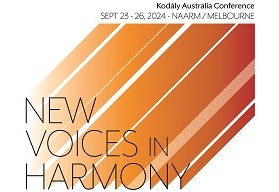David Banney
This article explores the use of modal transformation in both musicianship classes and string teaching.
It would not be an exaggeration to say that my first visit to the East Helsinki Music School (the home of Colourstrings, and the workplace of Géza and Csaba Szilvay) was a life-changing experience. Not only did it show me the great merit of the Colourstrings curriculum, but it also showed me the real value of a systematic, comprehensive system for teaching musicianship, such as the Kodály approach.
One of the most memorable moments during that first visit happened during a cello lesson, given by Csaba Szilvay to an eleven year-old boy. By Csaba’s standards the boy was a fairly average student, and I was astounded when, halfway through the lesson, Csaba put him through a seemingly grueling set of exercises in modal transformation. ‘Play the Mosquito Song in the Lydian mode starting on C# on the G string’. ‘Now play it in the Phrygian mode, starting on F on the D string’.
The result was not always perfect the first time through, but corrections were made easily, and the second or third time through usually was perfect. When, after the lesson, I expressed my amazement to Csaba, he simply shook his head and muttered, ‘This boy is so lazy I must give him these games’.
The truth is that for students with a thorough grounding in sol-fa, modal transformation can be a game, and a very useful and enjoyable one at that. (Modal transformation is the term applied to taking a song in one mode and playing it in another. eg, playing ‘Twinkle, twinkle’ (usually in the major scale or Ionian mode) and playing it in the Lydian mode.)
There are many valuable uses of modal transformation, both for musicianship and for string playing, some of which are summarized below:
- Modal transformation is a good way to introduce the concept of modes, and to consolidate the understanding of modes;
- Modal transformation is a challenging and enjoyable way of introducing sol-fa to older students with previous musical education, but no previous sol-fa;
- Modal transformation challenges string players to find and consolidate many different finger patterns.
After a brief revision of the modes using sol-fa, the rest of this article will give some strategies for using modal transformation in the teaching process.
Sol-fa and the modes
There are two important approaches to understanding the modes using sol-fa. In the first approach, each mode is treated as beginning on a unique scale degree – the Dorian begins on re, the Phrygian begins on mi, the Lydian begins on fa etc (Fig 1). However, in practice, this approach is often unhelpful, and a 2nd approach is often preferable.
In the second approach, each mode (excluding the Locrian) is treated as either a major (do) or minor scale (la) (determined by the presence of a minor or major third), with a unique chromatic alteration (Fig 2). In this approach, the Dorian mode is a minor scale with fi instead of fa; the Phrygian is a minor scale with ta instead of ti; the Lydian is a major scale with fi instead of fa, etc. It may be seen that in each scale the pentatone is preserved (do, re, mi, so and la). The altered note in each mode is either fa or ti. The Ionian and Aeolian modes have no chromatic alteration – these are our familiar major and minor scales. How to choose the appropriate approach for a given song is beyond the scope of this paper, but in introducing modal transformation, this second approach is most helpful.
Figure 1 First approach to the modes – each mode begins on a unique scale degree.
Figure 2 Second approach to the modes – each mode is either a major or minor scale with a unique chromatic alteration.
Modal transformation
1 – Modal transformation for introducing and consolidating the concept of modes.
I remember my first introduction to the modes. It was a Saturday afternoon, and as a young high school student I was attending a Saturday music school, where a well-meaning teacher introduced us to this mysterious subject. Without giving any musical examples he explained that there were 7 modes – six important ones, and a 7th less common one. The important ones could be remembered by the following mnemonic: ‘Am I Dumb? Poor Little Me!’ (Aeolian, Ionian, Dorian, Phrygian, Lydian, Myxolydian). The mnemonic made a great impression on me, and whetted my appetite to know more about the modes. Sadly, it would be more than two decades before, through sol-fa, I gained a real understanding of the modes. Even a music degree left me with only the vaguest notion of what the modes are all about.
The problem in the typical teaching of modes is two-fold. First, too much is taught too quickly. Students are expected to understand all the modes at once. Secondly, and perhaps even more importantly, students are rarely given the opportunity to really feel the harmonic significance of each mode. Even if musical examples are given, they are usually so far outside the experience of the average student that modes are regarded as yet another aspect of music theory that is learnt for an exam and then quickly forgotten.
Modal transformation solves both of these problems, as will be discussed below.
It is worth remembering how we teach the pentatonic and major and minor scales to children. We typically begin with just two notes, building systematically towards the pentatonic scale, only later introducing the major and minor scales. The same applies for the modes – it is not necessary to learn all of the modes at once and neither is it necessary to use the whole of a given mode in the first instance.
Exploiting the ‘discovery’ process
Modal transformation allows children to discover the modes. Simple melodies known by heart by the student provide repertoire for the teacher to demonstrate in various transformations, and then for the student to imitate. The child must discover the sol-fa of each new version before a name is given to its mode. Only one mode need be introduced at a time, and with regular reinforcement children will quickly learn the skill of modal transformation for themselves without needing to imitate the teacher. In my violin teaching I first introduce transformations from major to minor and vice versa. Perhaps one term later, the students are ready to learn a new mode – I begin with the Lydian, and once this is well established I introduce the Phrygian mode.
Begin with small tone sets
I have already discussed the idea that the modes may be thought of as alterations of the major and minor scale. While each mode is a complete scale, it is not necessary to use the entire scale to understand the chief characteristics of the mode. Fig 3 shows the smallest tone-set possible for appreciating the chief characteristic of each mode. The tetrachord is the minimum tone-set for any mode, even for the Phrygian mode, where the altered note is the second degree of the scale. The choice of Lydian and Phrygian modes as a starting point is based on the fact in each case the characteristic ‘altered’ note occurs in the lower tetrachord. This means that tetrachordal and pentachordal melodies may be used – a much simpler approach than using melodies that use the entire scale. Tetrachordal melodies allow for an appreciation of the Ionian mode (or major scale), Aeolian mode (natural minor scale), Lydian mode (major scale with fi instead of fa) and Phrygian mode (minor scale with ta instead of ti). Hexachordal melodies are required to demonstrate the Dorian mode (minor scale with fi instead of fa). The entire scale is required to understand the Myxolydian mode (major scale with ta instead of ti). In my teaching the Locrian mode is not introduced until the other modes are well embedded.
Figure 3 Minimum tone-set required for establishing the chief characteristic of each of the six main modes.
Once introduced, the use of modal transformation need never stop in the teaching process. As the student gains more experience, longer and more complex melodies may be used, and the use of modes in folk music and art music may be explored in great depth.
Internalising the harmonic implications of the modes
One very valuable aspect of this approach must be pointed out: modal transformation not only helps an understanding of the architecture of the modes, but more importantly, the feel of the modes. When students begin this process there are strong emotional reactions to these transformations. ‘Twinkle twinkle’ played in a minor key already changes the nature of the melody, but transformed into the Phrygian mode, one has the feeling that perhaps the stars will never twinkle again. Some students love the sound of it, some hate it – all students react in some way! Transformed into the Lydian mode we enter a fairyland where we can imagine that we are floating among the stars. No more are the modes the dry-as-dust property of academic textbooks, but living things that have nourished so much of the world’s greatest folk music.
2 – Modal transformation as an introduction to sol-fa for older students.
Introducing older students to sol-fa is a well-known challenge. The repertoire that is so useful in ECM classes is emotionally inappropriate for teenage starters, and repertoire that is emotionally suitable is often musically complex. Finding a way to fascinate teenagers with elementary sol-fa requires ingenuity and courage!
I have now used modal transformation on several occasions as a ‘hook’ for teenage choirs. Using ‘Twinkle twinkle’ in a warm-up and introducing hand signs and sol-fa, I quickly began a process of modal transformation, using major, minor, Lydian and Phrygian modes. The singers were asked, using hand signs, to identify the scale degree that had been altered, and once this was done successfully, I named the altered notes. Within a few minutes the choir was able to recognize and to sing on request ‘Twinkle twinkle’ in any of those four modes, using sol-fa and hand signs. On each occasion the singers immediately engaged with the process, and by the end of the rehearsal I was able to teach some elementary sol-fa (the material that I actually wanted them to know!) without any sense that I was being condescending.
3 – Modal transformation in violin and viola teaching
Fig 4 shows a simple tetrachordal melody in four different modes – Ionian, Aeolian, Lydian and Phrygian. Played on the violin or the viola, these four variants use four different finger patterns – in fact the four commonest finger patterns on the violin or viola (Fig 5). (The only other common pattern has two semitones – one between 1st and 2nd fingers, and the other between 3rd and 4th fingers. Less common patterns include an augmented 2nd).
In my violin teaching, the first use of modal transformation is to use tetrachordal melodies such as this (to begin with I choose melodies that are as stepwise as possible) to smuggle in the practice of finger combinations. By starting these tetrachordal melodies on fingers other than the first finger, or by using songs with larger range, string crossing is added into the mix.
Figure 4 Modal transformations of a simple tetrachordal melody
Figure 5 Finger patterns and modes associated with four different tetrachords in 3rd position on the violin or viola. The bracket marks the half-step in each finger pattern.
For students of the Colourstrings curriculum who have done regular transposition exercises modal transformation is an easily accommodated extension of the transposition process, and as with transposition, modal transformation is beneficial in the development of secure intonation. Students of other string methodologies may take a little longer to understand the concept, but generally enjoy the process, and derive similar benefits.
Modal transformation can be productively used for consolidating intonation within a given key. Choose a melody that begins and ends on different notes eg ‘Waltzing Matilda’ (the first half will suffice). Choose a key – eg G major. Play the song through as normal in G major, beginning on B and ending on G. Now start the song again, retaining the same key signature, but starting on the note that you finished on. This time the melody will begin on G and end on E, and the result will be the Aeolian mode. Start again, this time on E, finishing on C. This rendition will use the Lydian mode. Continue until all seven modes have been used.
This process will work for any piece that starts and ends on different notes. The process causes the student to internalize many aspects of the key, feeling its relationships deeper than just by playing the piece in its original mode. By returning to the original mode at the end of the process, the result will invariably be a significant improvement in intonation.
It is easy to see that modal transformation can lead into modal improvisation and composition without difficulty.
Figure 6 Modal transformations of Waltzing Matilda. Only the first two measures of the melody are shown. Each transformation begins on the final pitch of the previous transformation.
Conclusion
An excellent knowledge of the modes is essential for a deep understanding of the language of many 20thC composers, not to mention Renaissance music and a good deal of the world’s most beautiful folk music. The best way to come to grips with the modes is to use them, and modal transformation is a very useful way to do just that. As one explores the modes, one discovers that the modal world and the pentatonic world belong to each other. Modal transformation need not stay confined to the musicianship classroom – it may very profitably be incorporated into instrumental teaching, ultimately leading to modal improvisation and composition.
One last word of warning – modal transformation is addictive! For me, modal transformation is a daily activity, whether as composer, arranger or teacher. However, I know of no healthier addiction. May the modes bring you as much pleasure as they bring me!
———-
A past winner of the ABC Young Conductor of the Year Award, David has conducted many of Australia’s leading orchestras and ensembles. David’s deep interest in children’s music education was inspired by meeting Géza Szilvay, the great Hungarian violin pedagogue and creator of the Colourstrings curriculum. He has spoken at numerous conferences on the subject of music education, and is a
lecturer in musicianship, conducting and violin pedagogy for the Australian Kodály Certificate. As a music researcher, David’s interest is in the role of symmetry in music, and he was recently elected to the Executive Board of the International Symmetry Association.”









